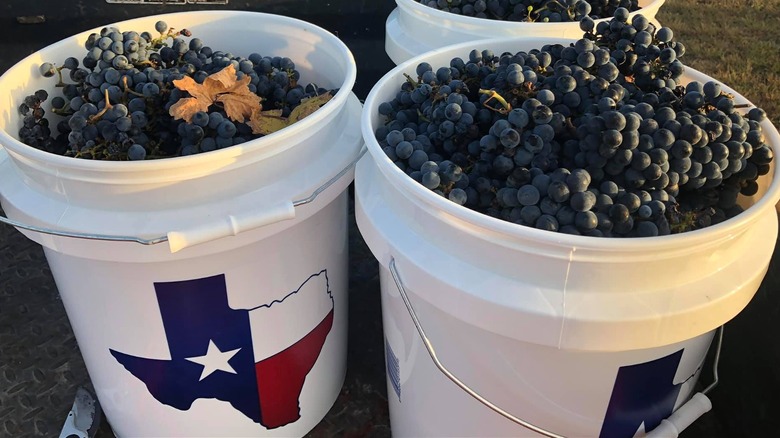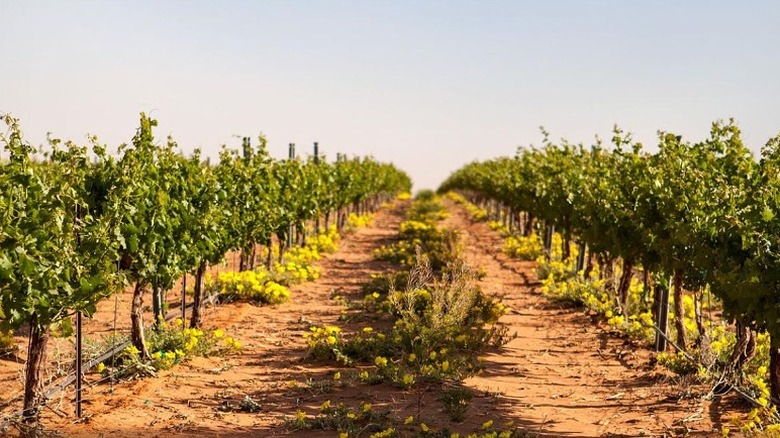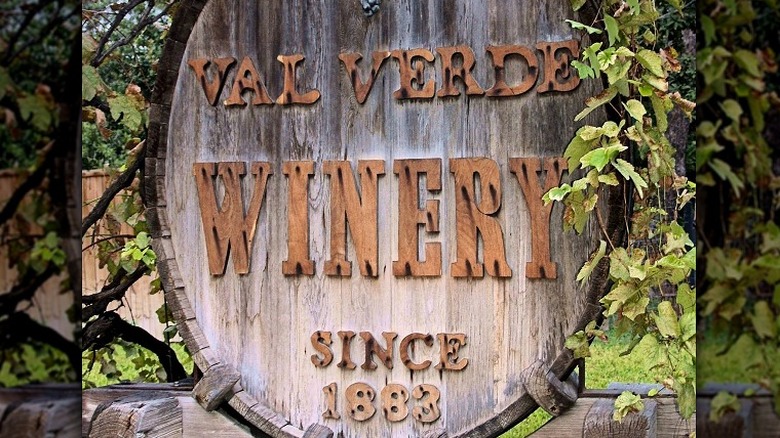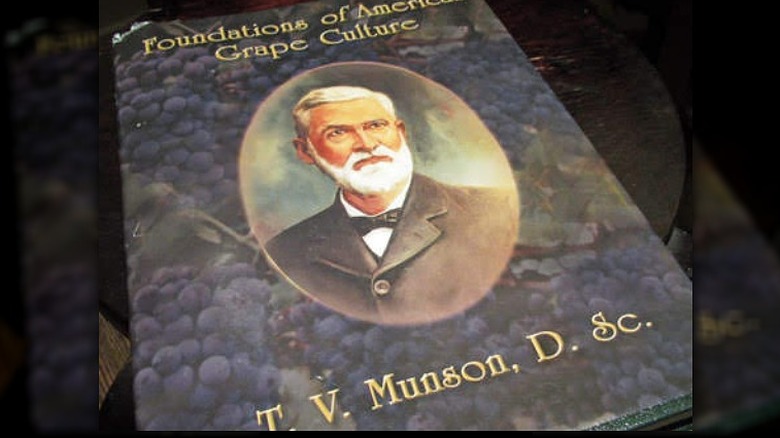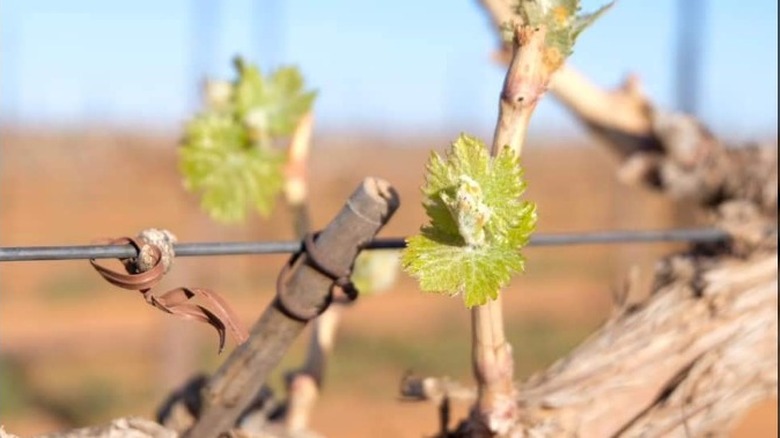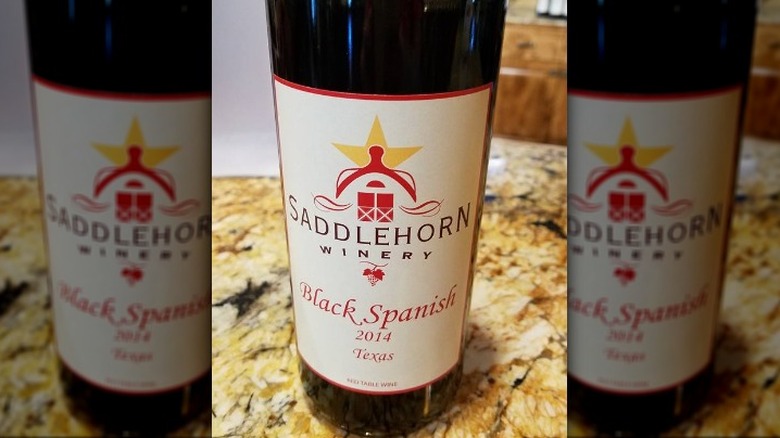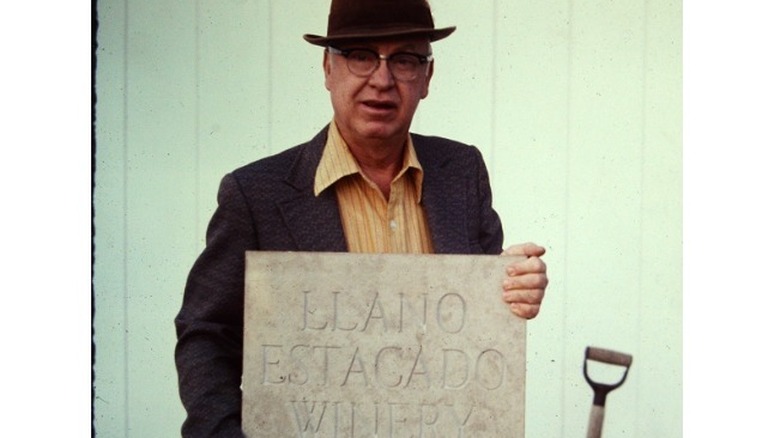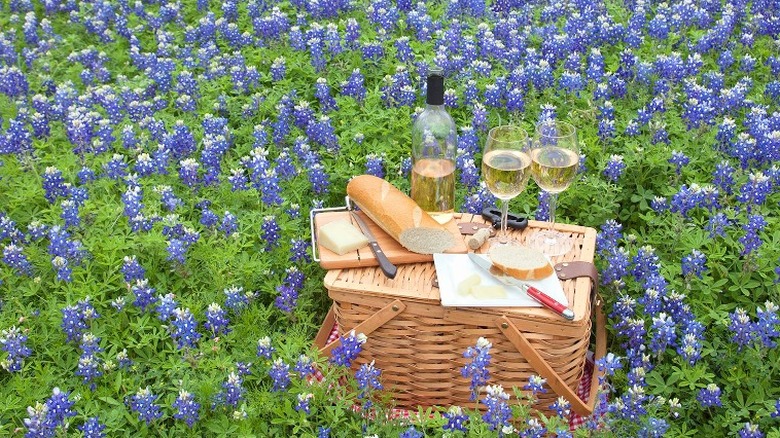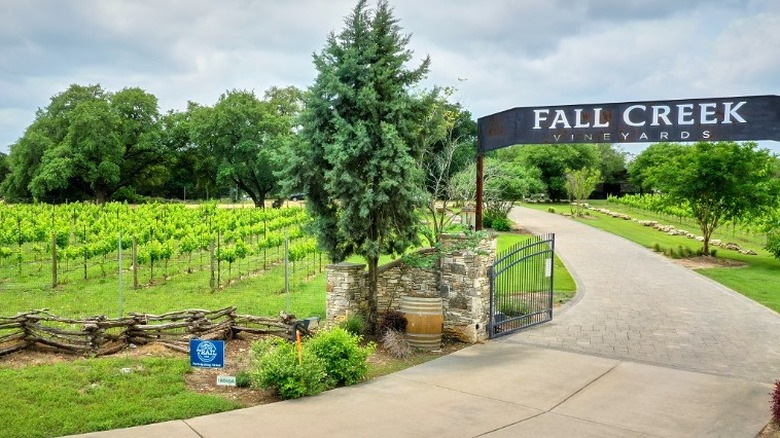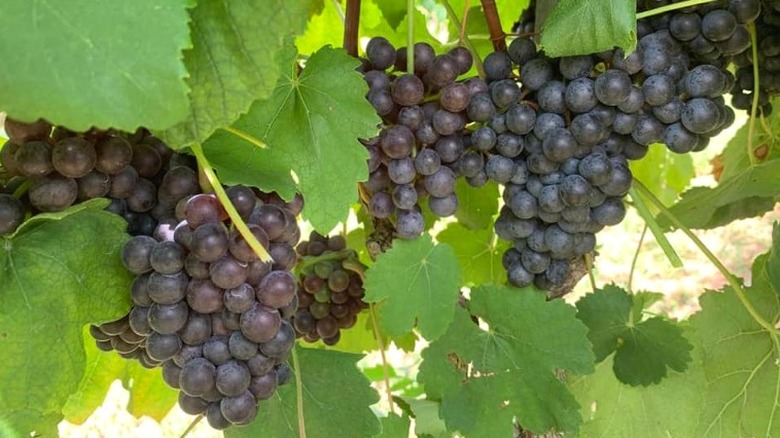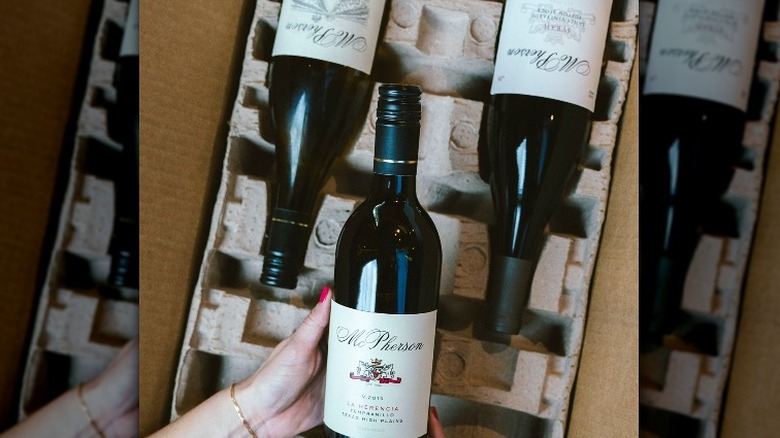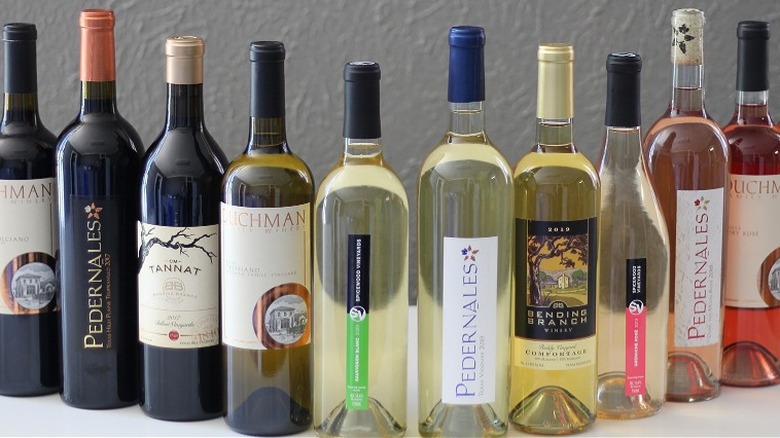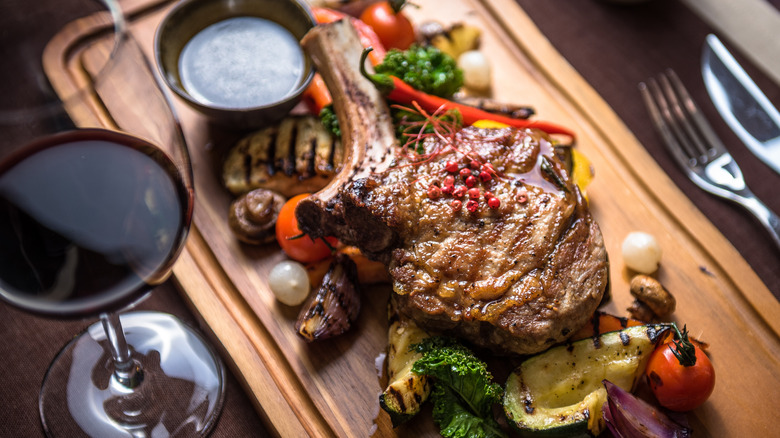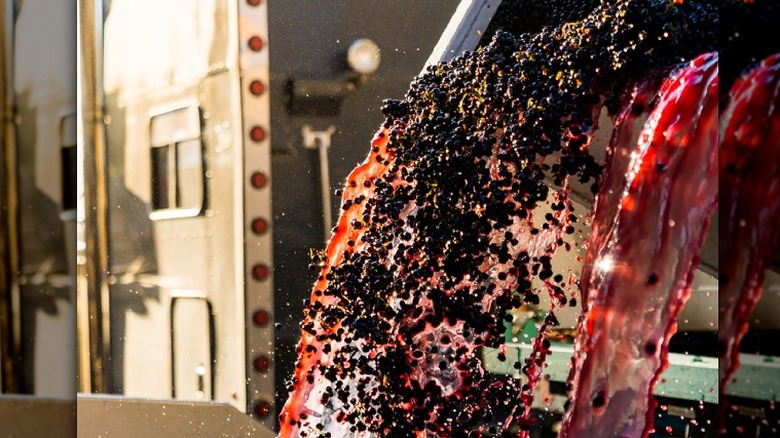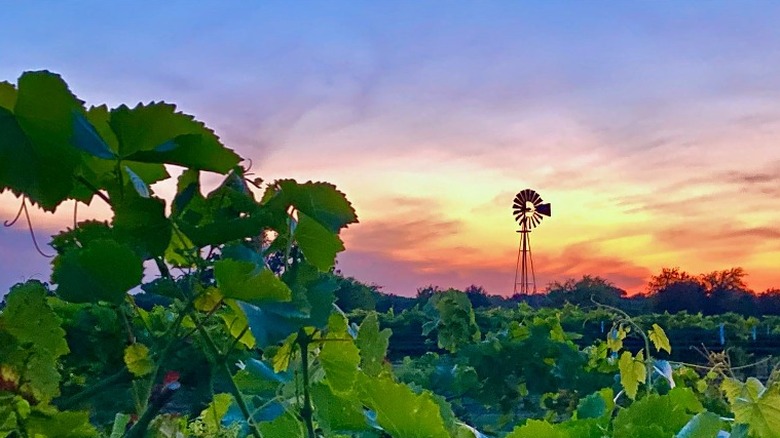The Beginner's Guide To Texas Wine
The founding father of Texas, Stephen F. Austin, once wrote, "Nature seems to have intended Texas for a vineyard to supply America with wines." With highly affordable land, a business-friendly environment, and a genuinely welcoming attitude, locals and transplants have grown the Texas wine industry to be the 4th largest wine-producing state in the country (via The Courier).
Dallas Morning News reports Texas has over 500 wineries and 5,000+ acres of vineyards planted, creating a $13.1 billion industry. It is a world-class wine region that might be in your own backyard.
The affordability brings many to the state, with an acre of land in Texas costing roughly $28,000 (via Land Search). However, the cost is still a fraction of California's per acre land cost of around $83,000.
Texas Fine Wine shares that 1.7 million people or more visit Texas wineries each year, which is a beautiful benefit of owning a Texas winery. However, tourism is not the goal. Wine Enthusiast reports that today's Texas winemakers are talking about the quality of Texas fruit, the expression of regional terroir, and the overall delicious taste of 100% Texas wine. Let's dive into the history of the wines of Texas and why you should drink a bottle tonight along with that bowl of Texas red chili.
Roots run deep in Texas
California may be the most prominent wine-producing state in the country today. However, they weren't the first. Years before Spanish missionaries planted vines in California, Texas was deemed a viable location to grow grapes. UC Davis shares that the first vineyards planted in California occurred in 1769. However, a century prior, Spanish missionaries planted the first vineyard in North America in 1662 near El Paso on the Rio Grade (via Authentic Texas).
The primary focus for producing wine came a century and a half later when predominantly European immigrants began to settle in the Texas Hill Country and Rio Grande Valley. Texas gained independence from Mexico in 1836, which was an attractive attribute to those seeking a new start. The Institute of Texas Cultures reports many German immigrants arriving in the state were tradesmen fleeing political and religious persecution in their home country. They settled near Fredricksburg outside of Austin in an area known as the German belt. When they arrived, they brought vine cuttings and began planting vineyards with grapes from their home country.
However, the Texas State Historical Association (TSHA) adds these varieties did not fare well in the Central Texas soils. Immigrants adapted, making a sweet-style wine from native wild mustang grapes instead.
The oldest winery in Texas began in 1883
As German immigrants settled in the Hill Country, Italian immigrants arrived in the south. Authentic Texas reports that in the late 1800s, Italian immigrants found south Texas along the Rio Grande near the border of Mexico appealing. They saw it as a place to plant crops and develop agriculture thanks to river springs and canals providing irrigation.
Among these immigrants was Francesco Quaglia, an Italian who quickly changed his name to Frank Qualia to sound more American. He purchased a small plot of land with ample irrigation and wild lenoir grapes growing and thriving in sun-drenched south Texas soils. Drawing upon the inspiration and knowledge from generations of family winemakers who preceded him, he made his first wines from the fruit. Thus began the Val Verde winery in 1883.
Val Verde Winery remains the oldest continuously-operating bonded winery in Texas. Texas Wine Lover adds it is one of the few that survived the difficult years of prohibition, making wine for the church and selling table grapes. Today, the winery focuses on native grapes, producing and bottling wine at its historic facility on Qualia Drive in Del Rio. Today third-generation vintner/winemaker Thomas Qualia utilizes old-vine lenoir grapes to create a fortified port-style wine, one of the common uses for the variety that is delicious paired with membrillo and blue cheese.
The grape man of Texas created 300 new varieties
Texans have viticulturist and grape breeder Thomas V. Munson to thank in part for the vast number of varieties planted in the state.
TSHA reports that Munson believed the grape was the ideal fruit for nourishment and profit. Widely considered to be the father of Texas grapes, Munson spent his life improving America's grape culture. He introduced 300 different American grapes by crossing native grapes and hybrids, creating varieties compatible with the arid, hot Texas environment. Though much of his work was with table grapes versus wine grapes, his research and findings around grape growing in America are still used by vintners.
According to Grayson College, while traveling extensively throughout the state in the late 1800s, Munson realized Texas's extensive biodiversity and varying microclimates made it the ideal place to grow grapes. Though Texas has intensely warm summers, the evenings are cool. The degree fluctuation, or diurnal shift, from day to night throughout the year ensures ripening grapes maintain balance. The temperature swings in the Texas High Plains, where most grapes are grown, can move up to 50 degrees of difference from day to night. These swing from hot to cold temperatures produces grapes with vibrancy, acidity, and freshness, balancing bold tannin and ripe fruit flavors.
Texas saved the world from the spread of phylloxera
According to the Vintner Project, the phylloxera louse unknowingly arrived in Europe on American vines imported into France in the 1860s. The vines were to help fight the oidium disease ravaging the country. American vintners had experienced the louse on its vines, but the pest only ate the leaves of the plants and did not harm the rootstock. Once in France, the parasite found the rootstocks of European wine grapes to be more appealing, feasting on grape vines under the surface while spreading from vine to vine above the surface.
Wine Enthusiast shares that by 1878 over 1.5 million acres of French vineyards were destroyed or dying while the parasite spread throughout Europe, South Africa, and Australia. The French government was determined to find a cure or solution to stop the spread, eventually turning to grape breeder Thomas V. Munson for help. Grayson College tells that Munson discovered a cross of Vitis vinifera, or wine grapes, with native varieties, which led to vines becoming phylloxera resistant.
As thanks for his work, the French government awarded Munson France's high honor, the Chevalier du Mérite Agricole, in 1883. Grayson University honored the Denison resident by creating the T.V. Munson Memorial Vineyard in 1975 and the T.V. Munson Viticulture and Enology Center in 1988 on the college's west campus.
Authentic Texas reports that the rootstocks Munson recommended are still widely used worldwide.
The black Spanish grape variety calls Texas home
The exact origin of the creation of a hybrid black Spanish grape is unknown; the inky black fruit is right at home in Texas. Wine-Searcher shares that the variety, also known as lenoir or Jacquez, is native to Texas. However, according to Texas Wine Collective, it may actually be native to Georgia. Either way, the American variety is widely planted in Texas due to its resistance to Pierce's disease, natural tolerance to phylloxera, and patience with heat and humidity.
Although called a black grape, this native red variety is one of the few fruits to have a deep black colored skin and dark ruby pulp, which gives the pressed juice a deep red color. Black Spanish variety wines are inky, dense, and tannic. Though the wines are full-bodied and powerful, the grape maintains acidity, creating balance in the wine. Despite it not being a widely used variety today, winemaker Willem Johnson of Deschain Cellars shares that it adds a welcome pop of fruit flavor and aroma in red blends.
Texas can thank Doc McPherson for its modern-day wine industry
The early 1900s saw a growing wine industry in Texas, but by 1919 that trend ended with the passing of the Volstead Act. It wasn't until the 1960s that the industry began to experience growth again. Much of this was thanks to a chemistry professor from Texas Tech University, Dr. Clinton "Doc" McPherson.
Wine Enthusiast shares that in the mid-1960s, McPherson began planting grapes in an experimental vineyard in the Texas High Plains, including the first vines of sangiovese in the state, along with dozens of other varieties. Working with a fellow professor Bob Reed, the duo researched what grape varieties would work best in the arid, sandy clay soils of the Texas High Plains. McPherson and Reed would go on to found Llano Estacado in 1976, the first post-Prohibition winery.
By 1990 over 1,300 acres and 17 varieties were planted throughout the region; today, the Texas High Plains is home to 75 wine grape varieties growing on 3,700 planted vineyard acres. Llano Estacado remains the largest production winery in Texas, crafting upwards of 170,000 cases annually.
In 2000, Doc's son, award-winning winemaker Kim McPherson, began McPherson Cellars. An homage to his father, McPherson Cellars showcases the immense quality found in the expansive Texas High Plains. Upon his passing, Doc McPherson's vision and leadership in putting modern-day Texas wine on the map were honored.
Texas has 19 wine trails
Today Texas has eight American Viticultural Areas (AVAs) and 19 wine trails (via Texas Wines). An AVA is defined as a wine-producing area with distinct geographic and climactic conditions, unlike surrounding areas. The Texas Hill Country north of San Antonio and west of Austin is the largest AVA in the state, covering over nine million acres of land and housing the most wineries. The Bell Mountain and Fredricksburg AVAs are within the Texas Hill Country AVA, defined as such due to each's unique characteristics and microclimates.
Though most wineries in the state are in the Hill Country, the Texas High Plains AVA grows the most fruit. Covering over 8 million land acres, the Texas High Plains AVA ranges from 3,000 to 4,000 feet above sea level with vast climate variances from day to night.
TSHA shares that the fertile, well-draining soils of west Texas near Lubbock appealed to farmers as growing grapes required less water than traditional crops like cotton. Today, most wine grapes grown in the state come from the Texas High Plains from over 30 different soil types.
Though the grapes may come from the High Plains, wine trails twist and turn throughout the state allowing visitors to taste and learn along the way. From the Bluebonnet Wine Trail outside of Houston to the Grapevine Wine Trail outside of Dallas, the state's 19 trails bring tourism and revenue to the growing Texas wine industry.
The Texas Hill Country is the largest AVA
Shortly after the establishment of Llano Estacado, Ed and Susan Auler established the first winery in the Hill Country, Fall Creek Vineyards.
Susan Auler spoke with Tasting Table about her early days in the wine business. She shared that their winemaking introduction was fate instead of intention. The couple had traveled to France in the early 1970s to buy cattle for the family ranch. Instead of touring farms, they toured vineyards. Auler said, "we spent 19 of those 21 days enjoying French wines and only two days reviewing cattle, which proved to be a fortuitous blessing. Within two years, we planted a small test plot of wine grapes on Fall Creek Ranch in Tow, Texas."
In 1975 the couple began Fall Creek Vineyards 80 miles north of Austin. A decade and a half later, the Auler's worked to establish the Texas Hill Country AVA.
Auler said, "Ed's legal background (a lawyer by trade), love of private aviation, and deep love of Texas geography were the tools he needed to make an application with the U.S. Government. From our initial French wine tour to each subsequent trip to wine regions worldwide, we realized each region had a definite sense of place in a specific site." She adds, "we would never put our wines on the world map until we created our sense of place. The Texas Hill Country AVA would hopefully be recognized as a great region for growing American wines in Texas."
Everything grows in Texas
According to Texas Proud, Texas is just a bit larger than France. Across the state's vast plains, hills, and valleys, dozens of wine grapes grow from cool-climate to warm-weather varieties with origins in Europe and America.
Susan Auler says that the Texas Hill Country "provides an endless variety of incredibly complex, mineral-rich soils, limestone, sandstone, and granitic hills. These soils are well suited for growing the highest quality wines. We believe that the Texas Hill Country is one of the ideal regions for selecting specific sites for specific grape varietals."
When Fall Creek Vineyards began, the focus was on traditional French varieties from Bordeaux and Burgundy. However, in more recent years, under the guidance of Chilean-born winemaker Sergio Cuadra, they now work with more warm climate grapes like tempranillo and mourvedre. Wine critic James Suckling said the 2016 Fall Creek ExTerra Tempranillo was an "outstanding American wine." Auler says, "Most great wine grapes will do well in Texas once they are matched to the right site."
Wine Industry Advisor's "Most Inspirational Winemaker 2021," Kim McPherson, believes Rhone, Spanish, and Italian varieties, like sangiovese, tempranillo, mourvedre, etc., are the best for Texas. The Locations TX winemaker shares with Andrew Chalk that everything can grow in the Texas High Plains, and vintners will plant the grapes a winemaker requests. However, they may not be the best suited for the environment. McPherson tells Market Watch that cool-weather varieties, like riesling and cabernet, do not make the best Texas wine.
Legislation changed the world of Texas wine in 2005
After years of fighting a difficult battle, Texas winemakers, distributors, and wholesalers finally agreed to work together to have Bill 877 passed in the Texas State Senate (via Wine Spectator). The bill allowed wineries to sell/ship wine across state lines to customers outside of Texas. Until this point, the sale of Texas wines remained mainly within the state as small wineries could not afford the expense of working with a wholesaler and distributor required in the state's three-tier system.
TABC regulations state that the winery can sell/ship up to 35,000 gallons of wine annually to consumers outside the state or to dry counties inside Texas. Further stipulations regulate sales of no more than three gallons of wine per month per customer, and the wine must be shipped to a 21-year-old or older individual. Opening the distribution via shipping channels allowed small production wineries to expand their business through direct-to-consumer sales from their websites.
Texas Wines range in price
Wine prices are all over the board in Texas. Some wine selections are highly affordable; some are very expensive. However, despite growing interest and support from consumers in and out of the state, high-end Texas wine sales are challenging for retailers. In a 2018 article, Market Watch shares that many wineries produce minimal amounts of wine, so their overhead for the total product is high. The site shares that the focus of many wineries remains on direct-to-consumer sales to tasting room visitors, with some focusing on sales to restaurants and online instead of working to have their wines sold through retailers.
Though you can find a bottle of $12 wine, there is a higher likelihood that the smaller production, high-quality wines will range from $40 into the hundreds. Fall Creek Vineyards ExTerra wines crafted from 100% Texas fruit grown in the Salt Creek Vineyard are $100 each. McPherson Cellars reserve sangiovese from Doc McPherson's historic Sagmor Vineyard is $36.
Texas wines pair with Texas foods
Texas is a rancher's paradise and cattle country. It is the land of burnt ends and brisket cooked low and slow at hundreds of barbecue joints lining Texas highways. It is a place you can buy a 42-ounce tomahawk steak in any grocery store in town. As the Texas saying goes, it is where you can get a "cab and a slab." In other words, the perfect pairing for this beefy palate is a robust Texas wine (which could be why the state's famous Salt Lick Barbecue sits directly across from Fall Creek's Driftwood, Texas vineyard).
Though there isn't a single signature variety state winemakers hang their hats on, there are common characteristics in the red wines of Texas. They are bold, fruit-forward, consistently ripe wines with high alcohol. This type of wine works well with the meaty diet many Texans enjoy. If tonight's menu includes smoked brisket or barbecue ribs, pair a bottle of high-tannin Texas tannat or a Rhone-style red blend and enjoy.
New regulations are defining Texas wine
In June of 2021, some Texas winemakers received good news years in the making. New labeling laws require that a single Texas vineyard wine must include 95% of the wine from that vineyard. The remaining amount must be grown in Texas. To label a wine with a Texas AVA, 85% of the juice must come from the stated region, with the remaining from within Texas (via Wine Business).
The new laws supported by the Texas Wine Growers are a game changer for many boutique Texas winemakers. Ben Calais of Calais Winery shared with Wine Enthusiast that Texas needs to be on the playing field with states regulating production, like California and Oregon, not those who aren't. The regulations ensure that.
The Texas Wine and Grape Growers Association initially fought the legislation, which took six years to pass. They note the opposition was due to the amount of fruit available in Texas could not meet the demand and production costs in Texas being higher than in other parts of the world. In the past, some wineries have also benefited from labeling their wines as "Texas-made," with the juice inside the bottle often coming from elsewhere.
The new guidelines change this behavior, with regulations ensuring authenticity by protecting the integrity and quality of Texas wines and elevating the industry. The standards will help define the sense of place of Texas wine bears.
Pierce's disease could be the death of Texas wine
Growing grapes can present a barrage of challenges from Mother Nature annually. Vintners can mitigate problems with proper planting and farming. However, Texas vintners find one issue quite challenging: Pierce's disease. The Texas A& M Plant Clinic reports that Pierce's disease is destroying Texas vineyards, likely due to the warmer winters over the last 30 years. Xylella fastidiosa, also known as Pierce's disease, blocks the water from being distributed through vines, eventually causing vines to shrink, wither, and die.
The disease spreads through insects like the sharpshooter, which remain in vineyards throughout the year due to warmer winters. Historically a deep winter freeze would kill the pests. However, global warming has curbed profound freeze events, adding one more concern for Texas winemakers battling climate change (via Forbes).
The disease is treatable with chemicals. The Austin American Statesman shares that most Texas vintners do not farm organically, making chemical treatment the path most wine growers take. However, some vintners are planting disease-resistant native varieties instead.
UT Rio Grande Valley shares that Pierce's disease cannot destroy the blanc du Bois and black Spanish grapes. However, the school's research adds that the wines lack the expected flavor profile American wine lovers enjoy today, making their use a double-edged sword. The vineyards would be safe; however, will anyone buy wine?
Only time will tell as the Texas wine industry grows, changes, and continues to find its identity while producing quality options.
